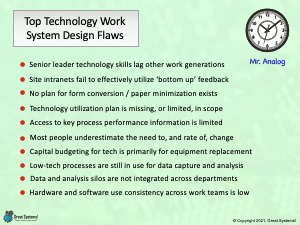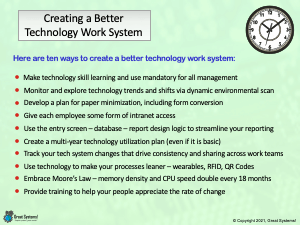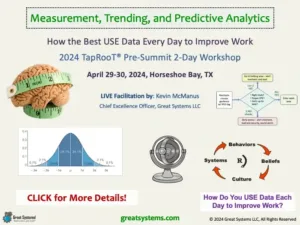Measure and improve your technology application work system to help utilize new technology such as RFID, voice recognition, and wearables.
Measure and Improve Your Technology Application Work System
I grew up the analog age. In turn, I had to learn to think digitally (it’s actually a work in progress) in order to better utilize emerging technology.
When I was in university, cable had just been introduced. VCRs were the thing to have. CD players had yet to make it onto the dorm room shelves. I did not use a personal computer to perform my daily work until I had been in the workplace as an Industrial Engineer for four years. Fortunately, I have learned a lot about how to measure and improve a technology application work system.
In the classic “Back to the Future” movie, Doc chides Marty for not being able to think fourth dimensionally. In today’s business world, many of our younger employees wish they could give their managers ‘the business’ as well for not being able think digitally.
The gap grows daily between the ‘before computers’ crowd and the ‘after computers’ crowd. How effectively do you utilize existing and emerging technology in your organization?
Ten Common Technology Application Work System Design Flaws

How Wide is the Technology Gap in Your Organization?
There are two potential dangers associated with this widening gap. First and foremost, if we don’t begin to close this gap, the younger crowd will begin to take advantage of, if not control, the older crowd. This will happen even though the wealth of the older crowd is paying for all of the neat toys (the technological infrastructure if you want to sound professional).
The second danger presents an even greater downside however. When we fail to acquire a digital acumen, we also fail to learn how to save a lot of time and money. More and more people feel excessive stress because of their workloads. Americans, at least, work more and more hours per week on average.
Because of poor technology use, we miss out on the potential to reduce our workloads significantly. We want to say it is the capital cost of new technology that is keeps us ‘as we are’. However, that is just an excuse. We just can’t comprehend the potential value of technology itself.
Think about it. We have managers who do pretty well with their cell phones, texts, and e-mails. These same people still struggle with programming the VCR or creating a Powerpoint presentation. The cost of slow typing alone would pay for the typing classes. The cost of continued paper use pays for the well-developed intranets that all too few companies have.
Where are Your Data Mines?
I can remember what it was like to do work without the aid of a computer. Armed with a calculator and white out tape, I would crank out version after version of cost estimates for the process engineers at the pen plant. In hindsight, if I had a PC to work with, I probably would have had one less IE peer to hang out with. Plus, it would have made things a lot easier, faster, and less frustrating.
Today, we have the means to both collect and crunch data very easily. That said, we also have too many people who don’t know how to even use the pivot table feature in Excel. Bill Gates himself said that the pivot table was the most important and powerful feature of the Excel package. That was before PowerBI.
This observation, along with others, leads me to believe two things. First, we fail to effectively analyze the important data we collect. Second, we don’t effectively use the volumes of data we capture.
The database has played a key role in my own process improvement efforts over the years. For starters, a dataset must be set up to capture waste events as they occur. Examples include material loss, downtime, or injuries. Plus, databases allow us to capture the details, and in particular the causes, of such events.
Before computers, we would fill out a form each time one of these events occurred. Then, someone had to sort through all of those forms and look for possible problem causes. Opinion ruled in the problem solving arena to a much greater degree that it should have. Back then, what cost effective options did we have?
LEARN MORE: Measure and Improve Your Measurement Work System
Where’s the Gold in Your Data Mines?
There’s a lot of gold in them there data mines. However, our failure to understand queries and other software features to create them keeps us from finding that gold. Additionally, bar coding, RFID, and wearable technology is now so cheap that it is almost archaic to hand enter anything!
Maybe the problem is not a lack of understanding. Maybe we remain locked in our ‘before computers’ mindsets. Do you get the most out of your data mines? How much gold do you leave in the ground each day?
In the digital world, things are actually pretty simple. We enter things into the fields of a database. The data is crunched, and reports capture the results. When we fill out a web form (entry screen), we fill in the fields of a new database record. The same thing occurs when we fill in the blanks on any computer-based form.
Ten Ways to Improve Your Technology Application Work System

One Simple Technology Application Work System Example
Unless you want to be fancy, the skills one needs to post pages to a website are not any different than those we use to create a Word document with pictures in it. You basically open a file, make your changes, and insert your pictures into text box-like tables. Then, you save the file to the intranet. As a result, you have either an updated or new web page.
In the past, it was more of a challenge to both create and post web pages. Also, it was pretty costly to set up an intranet. Not any more. Given the ease of installation and use that now exists, I believe that all managers and supervisors should know how to create, update, and post web pages. I’ve done it myself, so I know it’s not that hard.
Now, assume that all of your managers and supervisors have this basic skill. No one would have to make and distribute copies of the monthly report any more. We could sit at our desks or in the airport with a wireless connection and almost instantly look over performance reports, complete with graphs. Plus, we reduce the time lag to get the information. Even better, you could get feedback on the work almost instantly.
I am amazed that more organizations, even the small ones, have not gotten rid of more paper in favor internal web site use. If we would simply require each leader to learn and use this skill, we could save a whole lot of time and money. Additionally, with the advent of wearable devices, if the information is on a server, it can be on your people.
By the way, don’t forget that data can be easily accessible to your support personnel as well. This includes your value stream support groups such as human resources, information technology, and maintenance. How much waste and clarity do you think you might find if everyone could share more information more easily?
Would You Like to Improve Your Technology ApplicationWork System?
For over forty years, I have helped design and improve technology application work systems in multiple companies and a variety of business arenas. Even today, I continue to discover value added, simple ways to set up digital systems to measure daily performance.
Failing to think digitally is the primary power restrictor for this power system. If you like to make better use of existing and emerging technology on the job, let’s make a digital connection. Ultimately, I can help your organization better apply technologies as they emerge and become cost effective.
Keep improving!
Kevin McManus, Chief Excellence Officer, Great Systems
WATCH over 50 kaizen and workplace health improvement videos on my Great Systems YouTube channel.
CHECK OUT my ‘Teach Your Teams’ workbooks on Amazon.com
LIKE Great Systems on Facebook
© Copyright 2024, Great Systems LLC, All Rights Reserved



